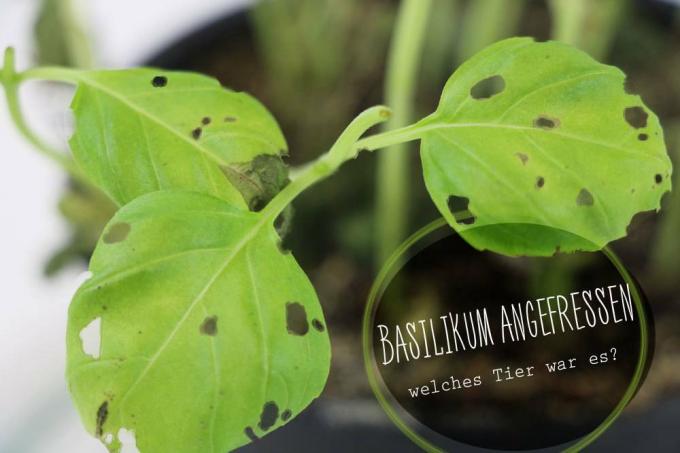
table of contents
- Eaten basil
- Snails
- Combat
- Common catchy tune
- Fight
- Vine weevil
- Damage image
- Home remedies
- Gamma owl
- Fight
- Leaf miner
- Combat
- Other animals
basil is widespread as a plant and culinary herb and is loved by some pests as well as humans. If the leaves of the basil are eaten, this is a clear indication of certain pests. Even some animals do not stop at Ocimum basilicum. In order to get rid of the uninvited guests and / or to protect the basil from them, the “culprit” must be identified in advance.
Eaten basil
If you discover traces of feeding on the leaves of the aromatic basil, you are probably wondering who is behind it. There are different candidates who are responsible for this.
Snails
If the leaves of the basil are eaten, then in most cases snails (gastropods) have tampered with them. They sneak out of their winter quarters on the plants in early spring when the temperatures are above the frost line. As a rule, they do not start to eat until the evening hours and especially at night.
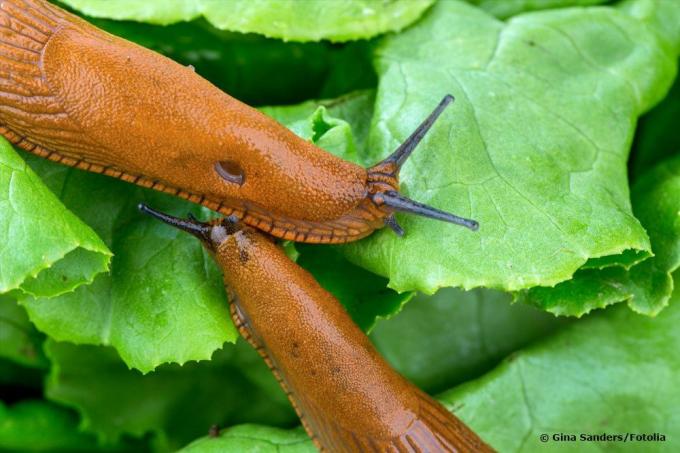
Appearance
- Elongated head with two antennae
- With a snail shell: the body rolls into it in case of danger or in sleep mode
- Without a snail shell: body curls up in danger or in sleep mode
- between different black as well as brown, brown-yellowish and orange tones
- Move in waves
- Leave slimy traces behind
- between 2.5 centimeters and 15 centimeters (large slug (Arion ater))
Damage image
- The basil leaves are pitted inwards from the edge
- Often holes in the middle of the leaf
- Rapid loss of baldness
- Traces of slime on the plant and possibly the ground
causes
They are almost attracted to basil and feel particularly comfortable in herb beds because you will find an ideal source of food here, which is the only reason for eating the Ocimum basilicum is. At night temperatures around 20 ° C and high humidity, they are particularly eager to eat.
Combat
There are various methods to choose from for combating snails, but not all of them work effectively or at all:
- At lower temperatures, collect cold-frozen snails early in the morning
- Erect a snail fence as a barrier (also available as an electric fence)
- Set up beer traps
- Place the sawdust a few centimeters high around the plant
- Spread the dried coffee grounds around the basil
- Scented plants as neighbors, such as lavender or gypsophila
- Only if nothing else works, resort to chemical poison traps
Common catchy tune
The common earwig (Forficula auricularia) is one of the flying insects and can often be found on basil plants from the supermarket. He is a Omnivores and leaves traces of feeding on all parts of the basil plant, from the leaves to the flowers to the stems. If he is not stopped, he will eat the entire plant, which, however, takes a longer time. It is active at twilight.

Appearance
- Six legs
- Body length: ten to 16 millimeters
- Body color: dark reddish brown, lateral thorax light brown
- Short stub wings
- 15-part feeler
- Two pincers on the abdomen
- Light yellow-brown legs
- One or two small teeth on the inside of the abdomen appendages
Damage image
- Feeding marks first on the leaves, then on the flowers, later on the stems
- Relatively small but numerous signs of eating
- Course quite slow
- Leaves lose stability
- Partly pitted roots that look like hollowed out as a result
- Usually not a life-threatening situation for the plant
root cause
As a rule, earwigs only appear near where they are Aphids on which they mainly feed. If the number of aphids decreases, the earwigs migrate to neighboring plants and eat the greenery and flowers there.
Fight
Fighting earwigs, or earwigs, as they are also known, does not necessarily require the help of chemical insecticides. Organic products and home remedies as well as tricks for relocation are more environmentally friendly. The latter is an intelligent solution, since catchy tunes are also among the useful insects counting.
- Surround the basil with sticky rings of glue
- Spray affected plants with neem oil two to three times a week (drives them away)
- Use / attract natural predators such as shrews, spiders and toads
- Relocating using a pot.
- Fill the clay pot with straw or wood shavings
- Place next to the basil (tilted to make it easier for earwigs to get in)
- On the following day, pour out the pot in a different place with ear pinchers
- Repeat the process as often as necessary
Vine weevil
The black vine weevil (Otiorhynchus) is one of the most feared garden and herb pests and cannot be deterred by the smell of basil. It is particularly active on warm summer days and remains so until the temperatures drop in autumn. If he finds his way to warmer climes, such as a winter garden, he can do without winter rest and continues his "mischief" there. He is crepuscular and nocturnal. During the day, he crawls where it is dark - preferably under the basil pot.
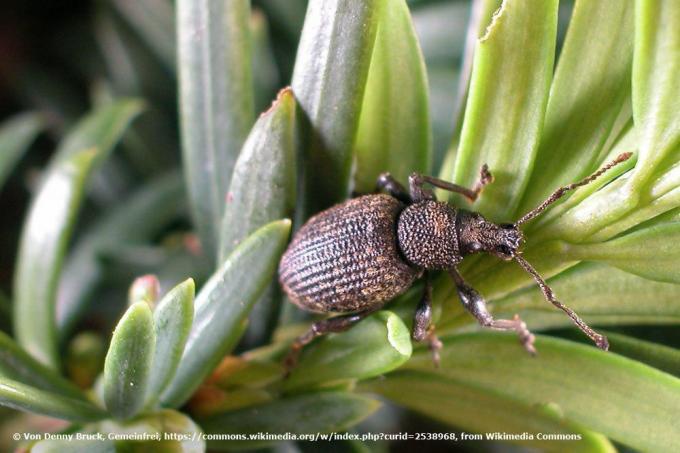
Appearance
- Looks like a beetle
- Six legs
- Two antennae and a thick trunk between them
- Body color: glossy black / dark brown
- Body length: about one centimeter
- Oval body shape
- Light yellow scale hair and longitudinal grooves on the back
- Don't fly, but run fast
- Cream-white larvae, hatch between August and October
Damage image
- Semicircular feeding marks on leaf margins
- Brown coating on places where it has been eaten
- Larvae gnaw on roots, plant hangs
- Flowers wilt, buds remain closed or fall off
- Larvae debark roots
- At an advanced stage, the roots are hollowed out
- Plant rapidly declines in vitality
- Without specific help, the plant dies
root cause
His favorite foods include leaves, buds or young shoots. Always hungry, he goes in search of his favorite dishes, including basil. In addition, the females need a place where they can lay their eggs in a protected place. If there is still peat-rich soil, the best conditions for black weevils are created.
Fight
If there is no egg deposition, so that there are only a few thick weevils, it suffers In most cases, plant no serious damage and control is not mandatory necessary. However, since they often overwinter in the root area and the females can lay up to 1000 eggs, the risk should be an "invasion" and the associated total destruction of the plant, through a fight in any case take place.
Collecting
A small, dark animal is hardly recognizable at night, so that it is hardly possible to collect it. Help is provided by a vessel filled with wood wool, which is placed directly on the Ocimum basilicum. The procedure is as follows:
- Fill the pot with wood wool
- Place with the opening facing down on newspaper or similar (right next to the basil)
- Raise the edge of the pot with one or two stones in the direction of the plant so that pests can run into it
- Pests will use this as a sleeping place / hiding place during the day
- In the morning, lift / turn the newspaper with the pot and dispose of the beetles
- Repeat several times as not all bugs linger there
- Ideal time to collect: between May and August
tip: However, the beetles should never be disposed of in compost or elsewhere, so that the pests cannot get back on plants. Disposal should therefore always take place with household waste.
Home remedies
The appetite for the leaves and flowers can be taken away from them, if one Soft soap solution is applied. This does not harm the basil, but drives the black weevil to flee. This is how it's done:
- Dissolve 150 to 300 grams of soft soap in ten 10 liters of hot water
- Let cool down
- Pour into a spray container
- Spray the plant two to three times a week
- Perform for a few weeks depending on the extent of the infestation
- Also helps in prevention
Nematodes
Nematodes are tiny nematodes that are used effectively against larvae. If these come into contact with the nematodes, they become infected with mutating bacteria and die. The roundworms can be bought in specialist horticultural shops.
Gamma owl
Gamma owls (Autographa gamma) are insects and are moths with day and night activity. They too can be responsible if basil is eaten. Their caterpillars in particular cause enormous damage to plants every year, while even as larvae they usually do not cause the plant to die. If this is not prevented, between two and three new generations form on the Ocimum basilicum per season from May to November.
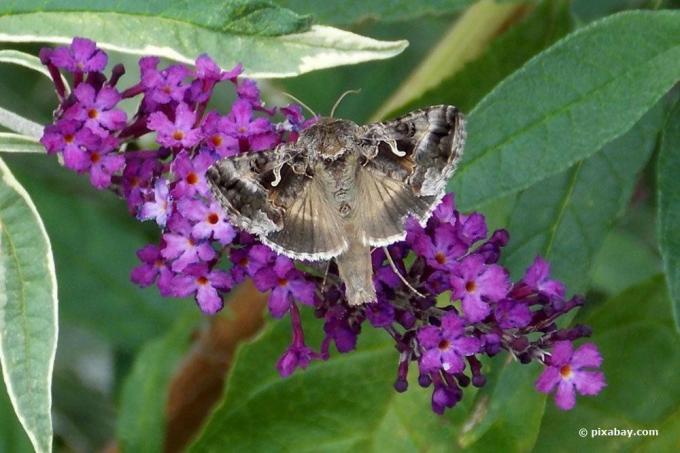
Appearance / recognition
- Whitish larvae between 30 and 40 millimeters long
- Caterpillars: green head, green to blue-greenish body color, yellow-green lateral lines with black stripes
- Moth: gray-brown to reddish-brown
- Wingspan: 35 to 40 millimeters
- Front wing with clear silver-white "gamma flaw"
- Eggs on the underside of the leaves
- Web on the plant from which the offspring emerges
Damage image
- Initially small holes in the leaves - often with a slight yellow color
- Later the leaf margins and stems of the basil are pitted
- Growth peaks destroyed
- Leads to the skeleton fry
root cause
As butterflies, they primarily follow the scent trail of flowering plants and, after they have been eaten off, also like to settle on neighboring green plants without flowers. They prefer weakened basil and love long-lasting dryness.
Fight
- Mashing egg layers
- Removal of heavily infested parts of plants
- Effective control in the larval stage with nematodes (as described under "black weevil")
- Spraying with neem oil (clogs the airways and makes them die)
- Soap solution against the caterpillars (as described under "Black weevil")
Leaf miner
The leaf miner (Agromyzidae) or their larvae often infest basil. However, a leaf miner infestation can be easily recognized by the damage.
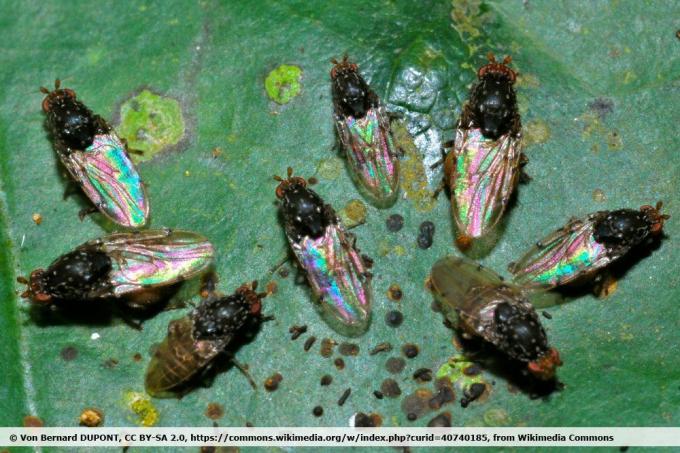
Appearance
- Larvae size up to three millimeters, whitish-yellow color, typical fly maggot appearance
- Miniature fly size: one to two millimeters - gray-black basic color with yellow spots
- Occasionally cream-colored eggs can be seen on the underside of the leaf
- Puncture points in the leaves (lay their eggs there)
Damage image
- Yellowish discoloration around puncture sites
- Minimal pitting at the puncture sites (larvae eat their way out of the inside of the leaf)
- Yellow or brown lines on the leaves (run through "mining passages" through the inside of the leaf tissue)
- Leaf tissue dies around the mining tunnels and dries up
- Fall of affected leaves
- Stunted growth
- Young plants die off quickly
root cause
In search of an ideal place to lay eggs and at the same time a source of food, leaf miners often lead to basil. Ideal conditions exist when compacted soil and / or a lack of supply weakens plants and there is even moisture.
Combat
- Cut off infected parts of the plant and dispose of them
- In the event of severe infestation, dispose of the basil completely
- Use of beneficial insects such as parasitic wasps and ladybirds
- Nettle stock.
- Chop around one kilogram of fresh or dried nettles
- Pour ten liters of cold water over them (nettles must be completely covered)
- Use a bucket with a lid / cover and place in direct sunlight
- Let it steep for between twelve and 24 hours and stir several times in between
- Then sieve out the stinging nettle remains
- Spray basil outdoors with brew several times a week (broth smells)
Note: Only nettles that do not have flowers are to be used for brewing, as these influence the effect.
Other animals
Cats
The cat is not an avid green herbivore and above all does not feel the essential oils attracted to basil, but curiosity and the urge to play can still eat basil leaves move. However, Ocimum basilicum is not toxic to them. Only a very young animal can react to basil leaf damage, which then becomes noticeable in the form of slight stomach and intestinal problems. To avoid leaf damage, a few tricks can help keep cats at a distance:
- Scatter pepper
- Demarcate with a rabbit fence
- Plant cat grass next to it (prefer cats)

Mice and rats
Mice and rats love basil, which is even available in dried form as a feed (additive) in specialist pet shops. However, this is not a good thing for herb bed owners, because eaten basil leaves should not be consumed, as diseases can certainly be transmitted. Apart from setting up classic mouse and rat traps, hobby gardeners and herb lovers have little else to do to solve the problem. It is still worth trying to keep them at a distance with the scents of garlic, savory, cucumber and / or thyme.


